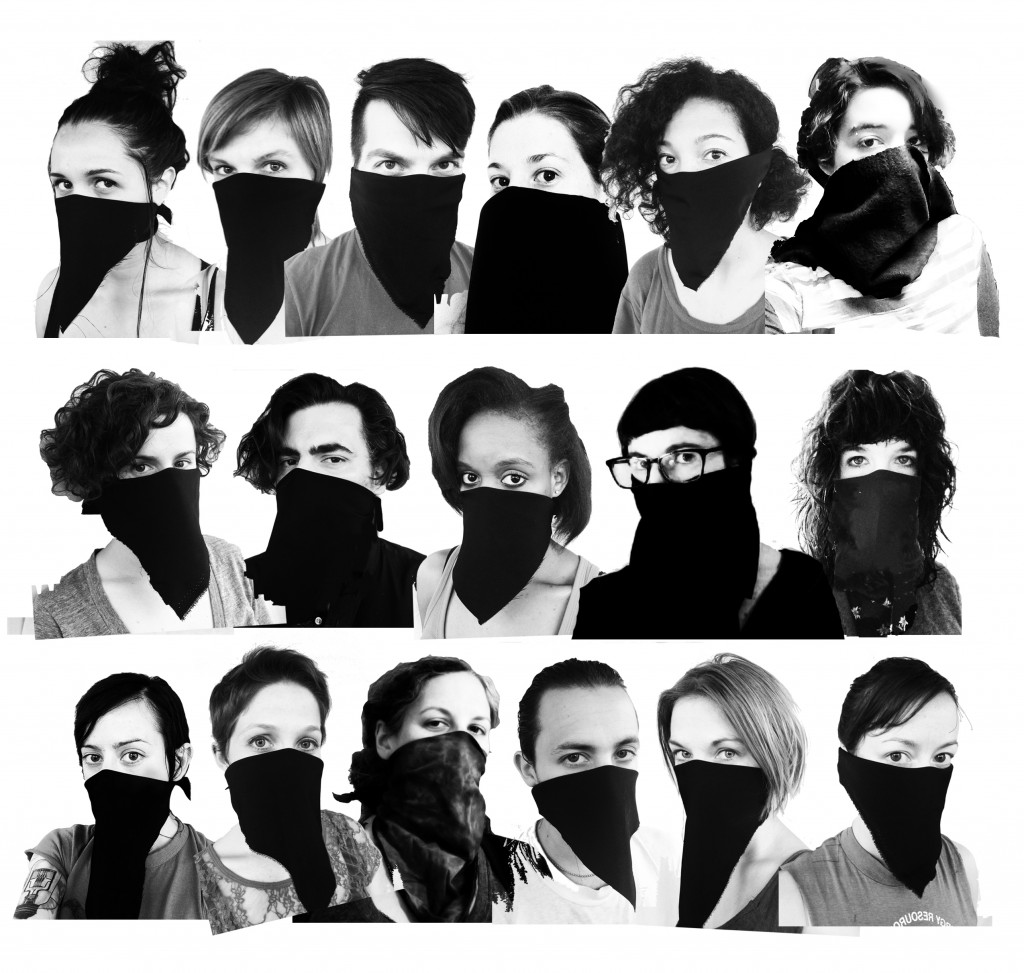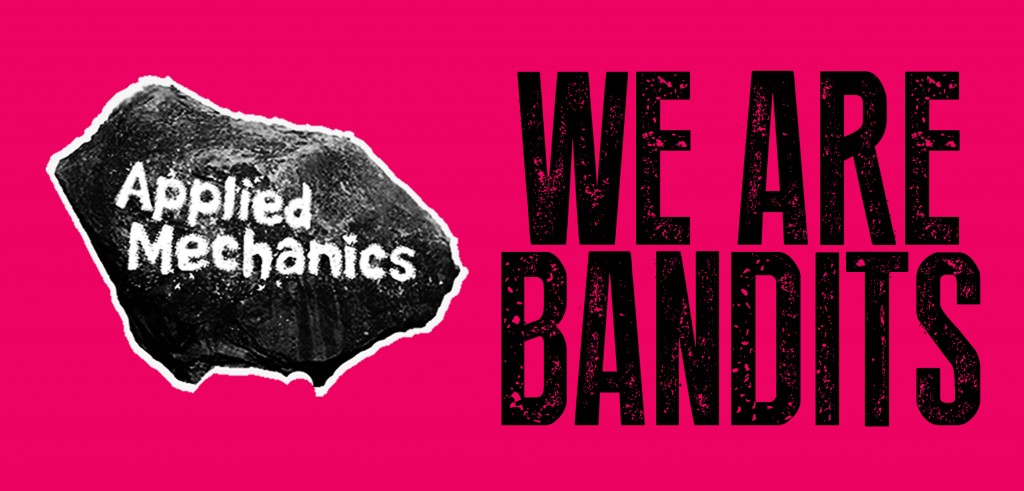 We finished our second leg of development on our July show, which has a brand new title: WE ARE BANDITS. (See video and indiegogo campaign HERE.) This title came about during an improvisation. (Our work is usually written from long improvisations in character — 30 minutes to an hour at a time.) In this improvisation, 3 characters were playing loud music illegally in a park. A character named Sharron (played by Aimé Kelly) realizes someone is recording her on an iphone. She pulls her scarf over her face, afraid of being recognized, and keeps on rocking. The other band members follow suit. Organically, unwittingly, they become Bandits. We started work on this show after being inspired by feminist group Pussy Riot, who are also bandits — people who hide their identities to work outside the law. In 2012, when they were caught or arrested by the police during an art action, they would give false names from an old Soviet database they found. They wear pastel balaclavas, which give them anonymity and immediate recognition at the same time — they are clowns, they are rebels, they are a collective, uncontrolled, lawless! Bandits!
We finished our second leg of development on our July show, which has a brand new title: WE ARE BANDITS. (See video and indiegogo campaign HERE.) This title came about during an improvisation. (Our work is usually written from long improvisations in character — 30 minutes to an hour at a time.) In this improvisation, 3 characters were playing loud music illegally in a park. A character named Sharron (played by Aimé Kelly) realizes someone is recording her on an iphone. She pulls her scarf over her face, afraid of being recognized, and keeps on rocking. The other band members follow suit. Organically, unwittingly, they become Bandits. We started work on this show after being inspired by feminist group Pussy Riot, who are also bandits — people who hide their identities to work outside the law. In 2012, when they were caught or arrested by the police during an art action, they would give false names from an old Soviet database they found. They wear pastel balaclavas, which give them anonymity and immediate recognition at the same time — they are clowns, they are rebels, they are a collective, uncontrolled, lawless! Bandits!
Since we are approaching this material from an American perspective, it seems only appropriate that we would replace the balaclava with a truly American symbol, a Wild West symbol. This symbol got me thinking about the idea of banditry in connection with activism, and the different kinds of activists that exist — the reformers and the rioters. There are the people who try to create change peacefully within the system (King, Gandhi) and those who suggest using force to wound the system (Malcolm, John Brown, Nat Turner). Society does not cotton well to change. It despises change, but that doesn’t mean it’s standing still. It is a train rocketing forward at a ridiculous pace on an unalterable path; the rails can only be adjusted by increments. Reformist activists say, “slow this train down!”, and some of them throw themselves on the tracks to slow the train down, and the bodies pile up and pile up, and usually it takes a lot of bodies on the tracks before the train actually agrees to slow down, let alone stop. So then, there are the rioters. The bandits. The bandits say, “You are stopping this train. I’m not giving you a choice.” They work outside the law. They chase the train down with horses, they will dig up the tracks and bend them, they shoot guns, they will use the tools of the oppressor against the oppressor, they will use violent means for good ends. Sometimes this only makes the oppressor guard his train better. More guns, bigger posses. But sometimes, the threat of a bandit can make the oppressor scared enough to listen to the reformer, the one who has been throwing herself on the tracks for so long.
Before this project started, the names of activists I could rattle off from the top of my head were generally male names. I didn’t know a lot about the history of women’s activism in America beyond the names in our schoolbooks: Susan B. Anthony, and… Harriet Beecher Stowe? Not much beyond that. I knew about reform, but not rebellion. I didn’t realize how many bandits there were in the history of women’s activism, and how many women had done outrageous, illegal things in the cause of Suffrage.
Mary Richardson, for instance, was a bandit. She was arrested nine times and spent more than 3 years of her life in prison. She was an arsonist, a window-smasher, a saboteur, a bomber. Most importantly, she was a suffragette. Mary saw members of her British suffragette society die painful deaths for their cause, die of punctured lungs from feeding tubes in prison. She was there the day Emily Davison threw herself in front of the train of history in the form of a speeding horse — George the V’s racehorse in its inaugural day at the Epsom Races. Emily stepped in front of the horse as it tore around the track; she was horrifically wounded and died days later. She wanted the right to vote. Mary Richardson saw that Emily’s act had no effect whatsoever on Business As Usual. She realized that sacrifice of human life was of no consequence to the people running and funding the train of society; the only thing they cared about was property. She devised an elegant piece of banditry. Her impetus was the imprisonment of Emmeline Pankhurst, the leader of the Women’s Social and Political Union. Pankhurst was in the habit of getting herself arrested; she saw it has one of the best ways to draw attention to the movement. In 1909, she struck a police officer twice in the face in order to get arrested. At her trial: “We are here not because we are law-breakers; we are here in our efforts to become law-makers.” Mary Richardson heard the call. She bought at axe and went to the National Gallery. She took the axe to a priceless Velasquez painting, called the Rokeby Venus. The painting featured a nude Venus, her back to the viewer, regarding herself in a foggy glass held up by Cupid. Mary’s axe hit the painting seven times. The guards rushed her, and some German tourists beat her over the head; everyone started beating each other; there was a riot in the National Gallery; no one knew why they were beating each other; there was total chaos, innocent people wounded, and when they finally got everything under control, and when Mary was sitting on the marble floor, bloody and exhausted, they asked her, “Are there more of your women in the gallery?” and she said “Yes” although it wasn’t so, and they were all panicked and afraid, and that’s what Mary wanted, she wanted them afraid of bandits. She wanted them to imagine suffragettes with axes, lurking around every corner. Lady Bandits, on the prowl, no respect for law and order. She put the fear of banditry in them.
“I have tried to destroy the picture of the most beautiful woman in mythological history as a protest against the Government for destroying Mrs Pankhurst, who is the most beautiful character in modern history. Justice is an element of beauty as much as colour and outline on canvas. Mrs Pankhurst seeks to procure justice for womanhood, and for this she is being slowly murdered by a Government of Iscariot politicians. If there is an outcry against my deed, let every one remember that such an outcry is an hypocrisy so long as they allow the destruction of Mrs Pankhurst and other beautiful living women, and that until the public cease to countenance human destruction the stones cast against me for the destruction of this picture are each an evidence against them of artistic as well as moral and political humbug and hypocrisy.” — “Miss Richardson’s Statement.” The Times. 11 March 1914.
I am excited to continue this work on We Are Bandits, in light of the history I’m learning for the first time. This is part of my heritage, and what Pussy Riot has done is now a part of that heritage — our show is participating in an international dialogue, centuries old. It is part of the process by which the community of women start to see themselves in the glass, darkly — the outline of our true worth getting sharper and sharper. We put on the balaclava, we put on the scarf, we pick up the axe. Time to make some good mischief.

